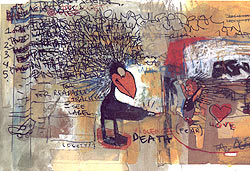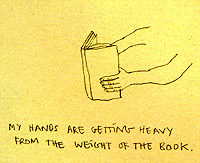Guided by Distraction | |
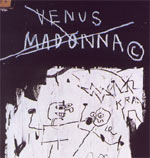
| I don't know about you, but I just blinked and was amazed, upon opening my eyes that it was nearly February 2001. I'm sure time really has sped up of late, although of course I expect it really is just because of my age and that I were to ask the gaggle of thirteen year olds who assemble in my room every lunchtime to squeel about The Sims and Popstars if they felt time was speeding way too quickly they would just look at me kind of funny and go on ignoring my presence as normal. Which is fine. But time... really... it IS speeding uncontrollably past, making me dizzy. So much to see and do and hear and love and hate; it all gets too much, it feels like all is shaking and poised to topple in slicing shards around my feet. Maybe that's just the state of being in these times though. Maybe it's not me at all. Long term followers of Tangents will probably have sussed that towards the end of 2000 that feeling of the world disintegrating reached such a point that only a pretty complete withdrawal from that world could bring back any kind of equilibrium. Looking back, it feels a little like an admission of failure; a failure of connection to the world at large, an admission that in fact nothing makes very much sense at all and that instead of being able to embrace that very madness and turn it to creativity, I was succumbing to the pressure of the mainstream that insists that all which fails to conform to the set of expectations determined by our media take itself off to hide away. Maybe I was over-reacting. Maybe I still am. A lot has happened since then of course. I just have to look at the tower of books and the mountains of CDs to know that much. And because I have this dumb obsessive character defect that leaves me with an overwhelming need to document and catalogue my life, I feel I ought to sit down and write about those towers and mountains. Maybe someone somewhere will even care. Like a million people before me and a million after me, I spent a while at the tail of 2000 obsessing over Jean Michel Basquiat. Is it still a cliché to say how much his paintings are fabulous evocations of an age and a rage? I'm not sure. It's a love/hate thing, I'm sure. I know of many people who can't take the importance given to him, don't rate him in the slightest. I think these people are wrong of course, think that such people are guilty of looking at the Art dislocated from the cultural milieu associated with it. Which is fine of course, but it's just that I happen to think it's pretty much impossible to look at Basquiat paintings without at least a slight understanding of the roots of Hip Hip culture in the New York of the late '70s and early '80s, at least a rudimentary understanding of the state of play in that city at that time. I keep saying that if I had a time machine, I reckon the only two eras I would like to visit would be New York in the mid-late '60s and New York in the late '70s and early '80s. They seem to me, admittedly through the rose tinted shades of cultural mythology, to be eras of extreme possibility, eras of deaths and births and then again, deaths. There is little I love more than the scratchy, edgy noises being made by the likes of Suicide, Talking Heads, Bush Tetras, James Chance/White; the void of PIL; the scotch-taped Hip Hop beats and sharp tongue rapping of the Furious Five or Crash Crew: all sounds that seem to at once record and amplify the fractures opening in culture at that time. Obviously I romanticise it, but I just have to look at footage or stills from that time and place and I fall apart. The colour and pattern that explodes on the subway trains, that seems to fall across every free fragment of surface in the environment, a snow storm of text, a multi-layering of meaning and inference. It makes me sad that the only contemporary equivalent seems to be the Internet; that where once such expression and freedom could be made physical, it can now only thrive in the 'virtual' space of electronic networks. That's another argument. |

|
Basquiat, it seems to me, so succinctly captures the fracturing of the world in his best paintings. He's a cartoon artist of course: obsessive, compulsive and addictive to the point of ridiculousness. Much like the Abstract Expressionists of the '50s with their alcoholism and macho posturings, Basquiat makes explicit a physical involvement in the art of painting, makes the drugs, sex and self-immolation an intrinsic element of the work. However, more than any of the other New Expressionists at the time, like Schnabel for example, Basquiat triumphs in that his painting makes very explicit connections to the everyday world of the Pop consumer, making the paintings much more accessible. Unlike his hero Warhol, however, Basquiat loads his connections to the Popist world with more obvious contempt and self-loathing, instilling in his work an eerie prediction of later evaluation of the decade with its glorifcation of money, corruption and extreme loss of empathic concern. Coincidentally whilst in the midst of my obsession, Film 4 in the UK screened the Basquiat movie. It is a quite hilarious, sad and annoying movie. Gary Oldman's Schnabel is hilarious, although I thought Julian was from Texas? Hmmm. Best is Bowie as Warhol. I was all ready to hate him but really he is terrific, especially in the scene where Basquait harasses the artist in a restaurant, getting him to buy some of his postcards. Bowie has the Warhol mannerisms off-pat, which lets face it isn't that hard, asking Bruno Bischofberger 'Oh gee Bruno, which one should I buy? They're all so great...' I think every artist should paint postcards; they are such fantastically beautiful and collectable things. It should be compulsory in every Art School around the globe. |
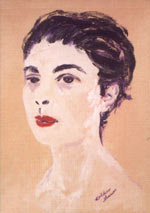
| Anyone interested in Basquiat will probably have sought out and read Phoebe Hoban's biography, and it is a great book if you want to follow the development of the whole Art/commerce scene in New York (and thence globally) in the 1980s. It also makes a passable job of illuminating the connections between the Art, music and culture of the times, although there's still a great tome to be written that ties it all together. Maybe it's publishers' fault for assuming that Art fans don't want to read about the music, and vice versa. Maybe it's the writers'. A more intriguing and prosaic book on Basquiat is Jennifer Clement's Widow Basquiat. Subtitled 'a love story', this beautiful book traces the intense relationship between Basquiat and Suzanne Mallouk. Mallouk, to all intent and purpose, and if you want to talk in such poetic and potentially archaic terms was Basquiat's main muse. There are several lovely paintings in which Mallouk appears, notably one called A Panel Of Experts where she is pictured in a boxing match with Madonna (another of Basquiat's innumerable 'conquests'). In the painting the word 'Madonna' is crossed out, and the word 'Venus' (his term for Suzanne) left untouched. The reason? Suzanne won the fight... Widow Basquiat is a rare achievement; a biographical picture of people, place and time that reads as a poetic Polaroid. |
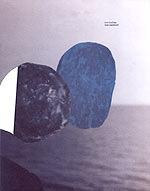
| Tangentially, I was reminded of Basquiat recently by a page in Tree Weekend, a collection of work by the Norwegian designer Kim HiorthÀy. The page in question is a design for a CD cover by Motorpsycho and is work of dense collage overlays, erasures, taut Twombly marks and Basquiat textual additions and cross-outs. They look terrific, the more so because they appear so odd in relation to the rest of the work in the book. This is obviously not accidental: Tree Weekend makes a wonderful (and largely successful) attempt to blur the boundaries between what Broadcast would term 'work' and 'non work'. Tree Weekend is as much a record of the design process as a record of the end results which so many books present and as such is immensely eclectic and enjoyable. The book collects photographs, film stills, drawings and computer-generated graphics, giving the impression of flicking through a sketchbook, or through the mind of the artist as he moves through his design process. And in fact to put it as traditionally as 'design process' is to do the book and the artist a disservice, because as already hinted at, HiorthÀy seems unwilling to make distinctions between what is 'design' (and hence 'work') and what is his 'other art' (and hence 'non work'). There are allusions made to this in the inclusion of small snippets of text which punctuate the images: a couple of letters in broken English from a friend, and most interestingly a series of short notes which are almost Zen like in their content. My favourite goes like this: In October I met Ole Andreas Holen at the botanical garden in Copenhagen. After looking at plants and flowers for a while we decided to go somewhere and have coffee. On our way out we got to discussing whether one should let one's work be disciplined and target driven. Ole said that he felt comforted by knowing that there was some end result to strive for. I said I thought it was better to just let oneself be guided by distraction and see where it led. A few moments later I walked into a signpost.
|
Tree Weekend is the most enjoyable book I've experienced in a while exactly because of this sense of distraction, boundlessness, variation and open eyed wonder at not only the world but also at the delight of creating something personal and new. For me, it captures the magic of how we might live lives in a state of almost childlike naiveté and wonder, of how the beauty in any moment might be at once instantly invisible and yet obvious: can be captured in a single image or series of images, and that it is the magic of the image that counts more than anything else. And wasn't it Warhol who insisted on the vitality and beauty of the image in and of itself? And isn't that a great concept to be accepting? © Alistair Fitchett 2001 Tree Weekend is published by Die Gestalten Verlag (ISBN 3-931126-37-4).
Widow Basquiat is published by the Payback Press, which is part of the very wonderful Canongate Books empire. www.canongate.net |
